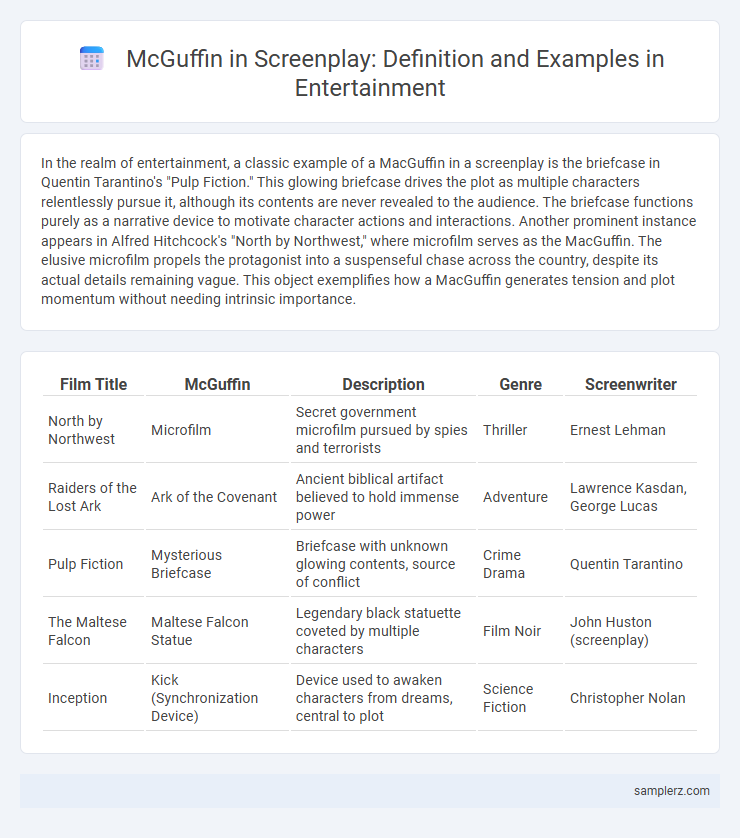In the realm of entertainment, a classic example of a MacGuffin in a screenplay is the briefcase in Quentin Tarantino's "Pulp Fiction." This glowing briefcase drives the plot as multiple characters relentlessly pursue it, although its contents are never revealed to the audience. The briefcase functions purely as a narrative device to motivate character actions and interactions. Another prominent instance appears in Alfred Hitchcock's "North by Northwest," where microfilm serves as the MacGuffin. The elusive microfilm propels the protagonist into a suspenseful chase across the country, despite its actual details remaining vague. This object exemplifies how a MacGuffin generates tension and plot momentum without needing intrinsic importance.
Table of Comparison
| Film Title | McGuffin | Description | Genre | Screenwriter |
|---|---|---|---|---|
| North by Northwest | Microfilm | Secret government microfilm pursued by spies and terrorists | Thriller | Ernest Lehman |
| Raiders of the Lost Ark | Ark of the Covenant | Ancient biblical artifact believed to hold immense power | Adventure | Lawrence Kasdan, George Lucas |
| Pulp Fiction | Mysterious Briefcase | Briefcase with unknown glowing contents, source of conflict | Crime Drama | Quentin Tarantino |
| The Maltese Falcon | Maltese Falcon Statue | Legendary black statuette coveted by multiple characters | Film Noir | John Huston (screenplay) |
| Inception | Kick (Synchronization Device) | Device used to awaken characters from dreams, central to plot | Science Fiction | Christopher Nolan |
Defining the McGuffin: A Screenwriting Staple
A McGuffin in screenwriting serves as a pivotal object, event, or goal that propels the plot and motivates characters without holding intrinsic value. Classic examples like the briefcase in "Pulp Fiction" or the ring in "The Lord of the Rings" illustrate how this device drives narrative tension and character decisions. Understanding the McGuffin's role helps screenwriters craft stories that engage audiences through focused objectives rather than the object's inherent importance.
Classic Cinema: Legendary McGuffins in Film History
The briefcase in "Pulp Fiction" serves as a legendary McGuffin, driving the plot through its mysterious contents without ever revealing them. Alfred Hitchcock's "North by Northwest" features microfilm hidden in a statue, creating suspense and propelling the espionage narrative. The Maltese Falcon in John Huston's classic is a quintessential McGuffin, symbolizing greed and deception while motivating the characters' relentless pursuit.
The Briefcase in "Pulp Fiction": Mystery as Motivation
The briefcase in "Pulp Fiction" serves as a classic McGuffin, driving the narrative through its enigmatic contents that remain undisclosed to the audience. Its glowing interior sparks curiosity and shapes character motivations, effectively maintaining suspense throughout the screenplay. This device exemplifies how a mysterious object can propel plot and character interaction without explicit explanation.
The Ring in "The Lord of the Rings": Epic Quest Catalyst
The One Ring in "The Lord of the Rings" serves as a quintessential McGuffin, driving the entire epic quest by motivating characters' actions and conflicts. Its immense power and corruptive influence create high stakes, propelling the narrative forward without the ring itself being the story's main focus. This object exemplifies how a McGuffin can shape a screenplay's plot by uniting diverse characters around a shared goal.
The Ark of the Covenant in "Raiders of the Lost Ark
The Ark of the Covenant in "Raiders of the Lost Ark" serves as a classic MacGuffin, driving the plot as the coveted ancient artifact sought by both Indiana Jones and his adversaries. Its legendary status and mystical powers create urgency and conflict, providing motivation without requiring detailed explanation of its intrinsic value. The Ark's role exemplifies how a MacGuffin propels narrative tension and character actions in adventure screenplays.
The One-Armed Man in "The Fugitive": Driving the Plot
The One-Armed Man in "The Fugitive" serves as a compelling McGuffin, propelling Dr. Richard Kimble's relentless quest to prove his innocence. This elusive antagonist embodies the critical clue that unravels the central mystery, steering the narrative forward. The character's symbolic significance heightens suspense and engages audiences through a classic pursuit-driven plot dynamic.
R2-D2’s Secret Plans in "Star Wars: A New Hope
R2-D2's Secret Plans in "Star Wars: A New Hope" serve as a classic MacGuffin, driving the entire plot by containing the Death Star's vulnerability details. The plans' secret codes are crucial to the Rebel Alliance's strategy, motivating characters' actions and conflicts throughout the film. This MacGuffin exemplifies how an object's importance lies in its impact on the storyline rather than its intrinsic value.
The Rabbit’s Foot in "Mission: Impossible III
The Rabbit's Foot serves as a pivotal McGuffin in the screenplay of "Mission: Impossible III," driving the central conflict and motivating character actions without revealing its true nature to the audience. This enigmatic object catalyzes Ethan Hunt's mission, emphasizing suspense and urgency while remaining largely undefined, a classic trait of McGuffins in storytelling. Its presence exemplifies how an elusive item can effectively propel plot development and character dynamics in action thrillers.
The Horcruxes in "Harry Potter": Objects of Power
The Horcruxes in "Harry Potter" serve as a quintessential MacGuffin, driving the narrative by embodying objects of immense dark power that Harry and his allies must locate and destroy to defeat Voldemort. Each Horcrux contains a fragment of Voldemort's soul, making their destruction essential to the plot's resolution and heightening the stakes throughout the series. Their significance as magical, soul-containing artifacts exemplifies how MacGuffins can propel character motivation and plot development in screenplay writing.
The Heart of the Ocean in "Titanic": Symbolic Obsession
The Heart of the Ocean in "Titanic" serves as a classic McGuffin, driving the narrative through its symbolic obsession and value. This fictional blue diamond represents love, loss, and the enduring human desire for connection amidst tragedy. Its presence motivates characters' actions, propelling the plot without requiring detailed explanation of its intrinsic worth.

example of mcguffin in screenplay Infographic
 samplerz.com
samplerz.com